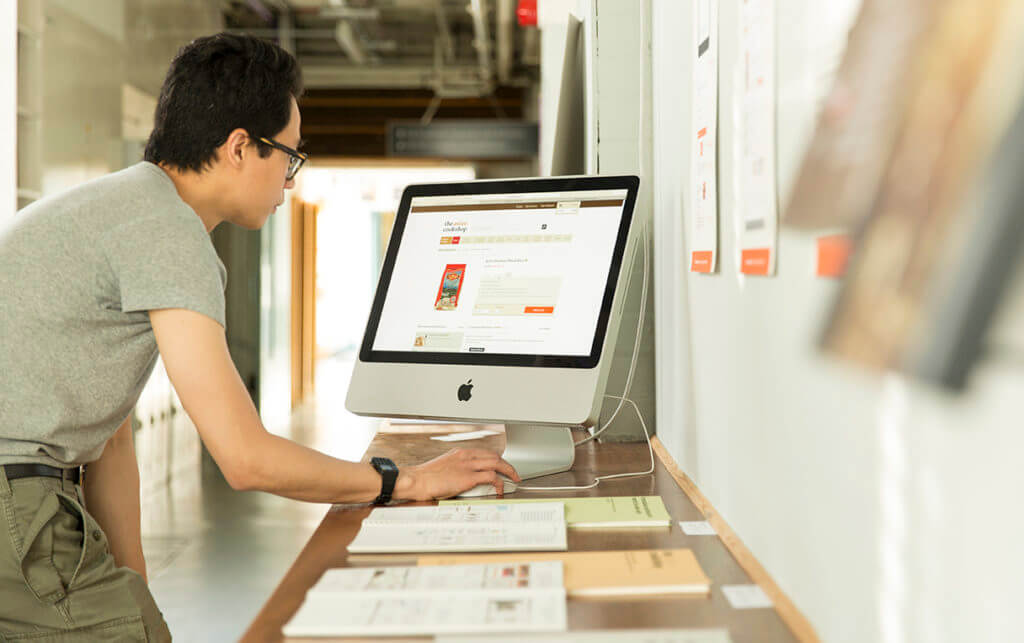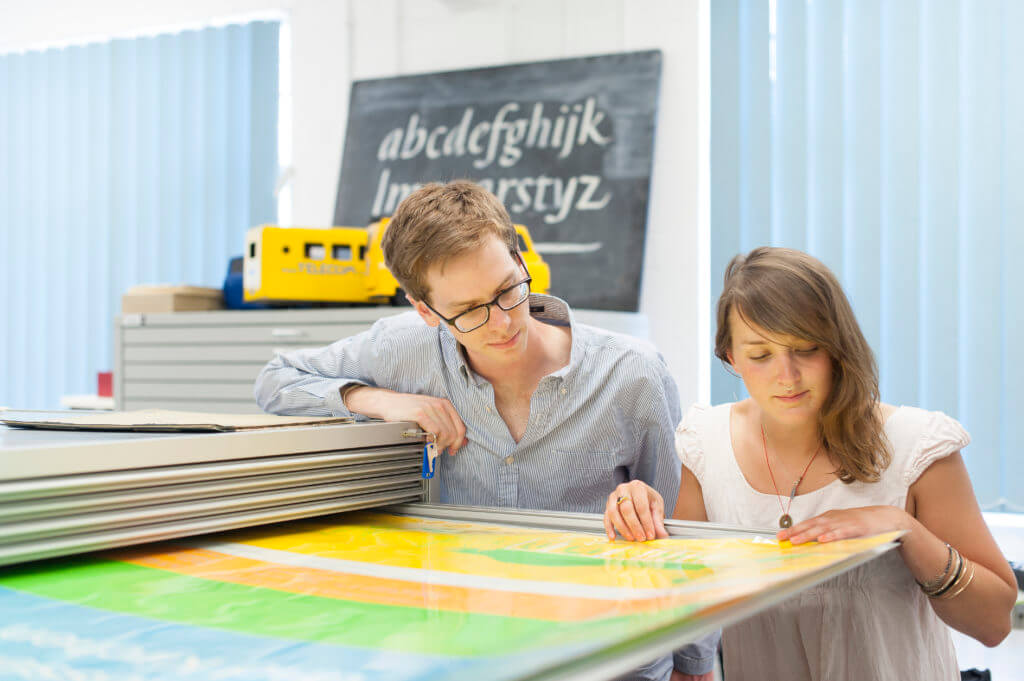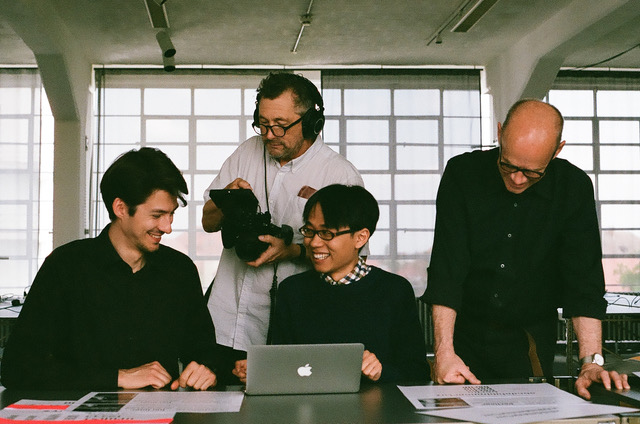Congratulations to postgraduate researcher Bodil Mostad Olsen who has won the University’s prize for research communication in a poster competition, held as part of the University’s annual Doctoral Research Conference. Bodil’s communication of her research topic – the history of health communication on food labels – was judged top among a very competitive field of posters representing research across a wide range of arts, science and social science disciplines. Her poster illustrates her collections-based research. It shows the changing influences of scientific understanding of food hygiene and nutrition, food packaging technology, and societal change on the presentation of food to consumers from 1850–1970. This area of typographic and graphic communication practice, although influential in people’s everyday decision-making, has not been considered previously from this wide, contextual perspective.
Category: students and graduates
—brace the space: Typography degree show 2019
We’d like to thank everyone who attended the private view of our degree show on Thursday evening. Our graduating class of BA Graphic Communication and MA Book Design students hosted a fantastic event which showcased not only their outstanding design work, but also their truly exemplary sense of teamwork and studio culture. Every aspect of the show – from promotion through to signage – is led by the students, and this year’s huge attendance and impressive co-ordination is testament to their efforts.
We’ll publish photos of the standout work on our flickr site shortly, and the student-run instagram is likely to fill up with more content soon. Meanwhile, if you’d like to see some of the work right away (including projects that won our coveted annual examiners awards), please do head over to the Department and ’embrace the space’ to enjoy the public view between Monday 17 and Saturday 22 June. The show covers everything from cutting edge UX to traditional book crafts, and there is an especially strong sense of experimentation and individuality this year.
For more information, visit https://embracethe.space

Creating flags to share identities at the Tate Exchange
In March, Typography’s ‘I am, we are … different by design’ project team designed and led a workshop to explore identity and movement as part of the Reading Assembly Tate Exchange. This year’s student team leaders Martha Macri and Seniz Husseyin look back on what made this such a successful day for all involved.
The Tate Exchange is an annual programme of events led by different educational partners hosted at the Tate Modern. Our University of Reading School of Arts & Communication Design were delighted to be invited back for the second year in a row to run our Reading Assembly in the first weekend of March. This year’s theme was Movement. Project teams in the School explored different interpretations of the theme to create fun and exciting activities for the public to get involved with.
Our ‘Different by design’ team for the day included: Camara Dick, Charlotte Prince, Labiba Haque, Liselot van Veen, Malaika Johnson, Martha and Seniz, supported by tutors Geoff Wyeth and Jeanne-Louise Moys. Our team is exploring ways to celebrate and explore diversity in creative disciplines. Our interpretation of the theme ‘movement’ was focusing on global movement and embracing everyone’s individual identities that reflect our diverse personal experiences, culture and journeys. Flags represent collective identities, so we wanted our participants to create flags that express their personal identities that we could collate to form a larger, composite and representative flag for the day.
Project management
In our weekly team meetings, we brainstormed and discussed ideas of what we could do for the workshop with the theme of ‘movement’. As a team we worked together and developed our flag idea. Martha and Seniz co-led the team, which meant we kept in regular contact with Anna Kontopoulou (the School’s Reading Assembly coordinator), identified what equipment and materials were needed and made sure all interim deadlines were met.
To ensure our activity would run smoothly on the day, our team set up a practice run of the workshop to test the process, equipment and to check for any altercations along the way. This proved a success as we perfected any aspects that needed changing and felt more confident as a whole. Overall, the planning process was spread over a few weeks.
On the day
Our workshop activity was designed to allow the public to express their identity through designing their own flag. We supplied them with paper to design on, readymade cut-outs of coloured paper and recyclable materials, as well as the option for them to create their own shapes and images. We encouraged the public to create anything personal to them and also displayed our team’s readymade bags to inspire or stimulate people’s creations.
Once the flags were created individuals handed them over to our scanning and printing section. We scanned the flags, not only to team. Our team printed these onto transfer paper and compiled all the flags into one collective flag showcasing everyone’s amazing work. The transfer paper printouts of each flag were ironed onto tote bags, enabling public partiicpants to take home a bag they designed themselves as a souvenir. Who doesn’t love taking things home after am eventful day out with friends and family…? We noticed that participants of all ages really liked this aspect of our activity and were happy to wait patiently to take home something they created, even when our ironing transfer queue was quite long!
Evaluation
The activity turned out to be a success with the table of crafting always being full and busy. We were happy that everything fell into place, ran smoothly and that our activity was popular to be a part of in the room on the day, highlighting that allowing people to express their identities is a good thing. The variety and quality of work the public created was wonderful to see and the collage of flags were inspiring to everyone.
Our team were very pleased that we received such positive feedback. We had people of all ages and backgrounds take part, from toddlers to Danish cabinet ministers, creating different interpretations of their own identity. All, however, expressed that they enjoyed their time and liked the idea of the activity – some people even stayed on the floor for hours. They especially enjoyed being able to take a tote bag home with something on it that they took their time creating. One person said: “I loved all of it. I would do it all over again”, which shows the positive impact it had on members of the public. The encouraging feedback has left our team eager to continue this workshop activity next year at the Tate Exchange and hope to be invited back.
Designing for an evolving publishing industry
The Department recently collaborated with Oxford University Press on an exciting digital publishing project. OUP’s brief gave final year students an opportunity to explore the challenges and possibilities of user-centred design for evolving digital platforms.
Presenting at the Reading Braillist’s meeting
Laura Marshall, one of our Part 3 BA Graphic Communication students, presented her dissertation research at the Reading Braillists meeting.
Typography alumni talks: a look at our future
Typography graduates from the past 15 years returned to give us an insight into how their careers have progressed since graduating.
Join us for our February 2019 postgraduate open day
The Department of Typography & Graphic Communication warmly invites prospective MA applicants to visit us for a postgraduate open day. The open day will be held in the Department on Thursday 28 February 2019 from 10.15–14.00. It’s a fantastic opportunity to find out more about the specialist postgraduate study routes we offer through exploring the work of past and present students and talking to our subject experts in Book Design, Communication Design, Creative Enterprise, Information Design, and Typeface Design. We’re also planning some talks that incorporate highlights from our world-renowned Collections and give you a taste of teaching and research at Reading.
We look forward to sharing with you exciting developments about how we’ve refreshed our postgraduate taught programmes to build a stronger, integrated typographic foundation for research and practice across all programmes and specialist pathways. We’ve introduced a new general Communication Design pathway to complement our well-known established pathways in Book Design, Information Design and Typeface Design. These four specialist pathways are all offered as part of our newly renamed MA Communication Design – the ideal degree for anyone wishing to develop their professional practice within a world-class research environment.

In addition to the practice-intensive pathways for the MA Communication Design programme, we also offer a multidisciplinary Creative Enterprise programme and two research-intensive programmes. Our MA Creative Enterprise is designed for individuals who wish to combine their study of research and practice in Communication Design with studies of management and law for the creative sector. Our MA Research Typography & Graphic Communication is the ideal route to prepare you for independent research and doctoral study and our MRes Typeface Design is a bespoke route for experienced, practicing typeface designers who want to develop a deeper understanding of the historical and theoretical aspects of their field.
To register your interest, please email Victoria Gifford – typography@reading.ac.uk.

Visiting Oxford University Press
Part 2 students who opted to design book covers for Oxford University Press in their design practice module were lucky enough to be given the opportunity to visit OUP headquarters in Jericho, Oxford.
Bauhaus typeface revived by MATD student
Adobe’s “Hidden Treasures” programme kicks off the typographic commemoration of the forthcoming centenary of the Bauhaus school by releasing four revivals based on lettering by Bauhaus staff. Drawing on original material in the archives of the Bauhaus Dessau Foundation, a group of current typeface design students were selected to work on digitising the original lettering, extrapolating the missing letterforms and characters to fill out the required character set, and adapt the designs for digital formats. The fast-paced project was led and supervised by Ferdinand Ulrich and Erik Spiekermann, and included in-person meetings in Berlin and Dessau, online collaboration, and a launch event in New York City.

Each of the four typefaces were revived by a student from a typeface design course: Hidetaka Yamasaki, a current MA Typeface Design student, worked on lettering by Carl Marx; Céline Hurka from the KABK on letters by Alfred Arndt; Luca Pellegrini from the ECAL on lettering by Xanti Schawinsky; Elia Preuss from HGB Leipzig worked on letters by Reinhold Rossig; and Flavia Zimbardi on letters by Joost Schmidt. The typefaces are released gradually through Typekit’s subscription service to professionals using Adobe’s dominant suite of applications, and are a superb example of archival material inspiring contemporary design.
Part 3s in Ravensburg

Erasmus-supported Teaching Fellow, Sara Chapman and nine of our Part 3s spent Week 6 in Duale Hochschule Baden-Württemberg (DHBW) in the mediaeval town of Ravensburg, Germany.
Students from both Reading and Ravensburg were working on the same ‘New Blood’ briefs from the D&AD 2017 competition.
Everyone enjoyed a very creative, inspiring and positive week away, during which both students and teachers were able to share skills and approaches.
After an intensive week working together in the shared studio space — sometimes up to ten hours a day — each student made a short presentation to the group about their project.
Students from Reading found that the Ravensburg emphasis on idea generation and conceptual thinking generated some unusual responses. Solutions tended to include a wider variety of multi-media outputs such sculpture, installation, and film making, as well as graphics. In comparison, the Reading approach was more pragmatic and decisive; we have a tendency to identify problems quickly, and use quite tight processes to solve them.
Whilst the Department has enjoyed an individual student exchange relationship with Ravensburg for some years, this was a new development in that a greater number of students could experience a short time in Germany, that complimented their degree studies. We hope to invite German students on a return trip, and also to repeat the collaboration in Spring 2018.
We are grateful for the support from the Ernest Hoch fund for covering the students’ competition entry fees and IMAGINE for covering the students’ travel costs.
